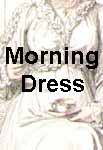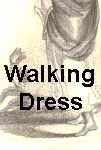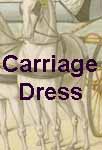| "Undress" meant simply casual, informal dress in
the Regency period. It was also called "dishabille" or "deshabille," the French word for the same
type of dress. Another clue is anything "negligently worn" or "à la négligé"
is probably either undress or designed to resemble closely undress. Undress is the sort of dress to
be worn from early morning to noon or perhaps as late as
four or five, depending on the engagements one had. Compared to half dress and full dress, undress is usually more
comfortable, more warm, more casual, and much cheaper in cost. Morning and walking dresses are
almost interchangeable and often you get something labelled "Morning Walking dress." Walking
dress is usually morning dress with some type of wrap and of course
a more elaborate headdress, such as a bonnet, hat, or turban. When a morning dress is called
"domestic dress" or "home dress," it is usually shown in a fashion plate as indoors with a cap or
headdress of mainly hair. (Another favorite with morning dress is the capote or cap-bonnet,
a sort of blend of a cap and a bonnet.) The distinction between morning and walking dress is often
that between a hostess and a visitor paying calls; the hostess is in a domestic or morning dress while
the visitor is in a walking or morning-visiting dress.
Promenade dress is distinguished from walking dress in that it is designed
for the social ritual of promenading in the park, walking to see and be
seen in London or at a fashionable resort. Promenade dress is thus sometimes
considered half dress and is more elegant than walking dress. Carriage
dress is like promenade dress, but one is to be seen in a carriage, not
walking. Riding
dress is sometimes depicted with other morning or walking dresses,
but because of its distinctive design, I do not include it here. Promenade,
carriage, and riding dress are mostly associated with the social rituals
of fashionable parks. The fashion writer for The Lady's Magazine often complains there are no new
fashion trends to report because the weather has kept fashionable women
in from the parks. The implication is the writer is not privy to the highest
circles of society and relies on public displays for information. Of course
fashionable modistes or mantua-makers (the common names for regency dressmakers)
are also good sources for the periodicals of new fashion trends.
|




